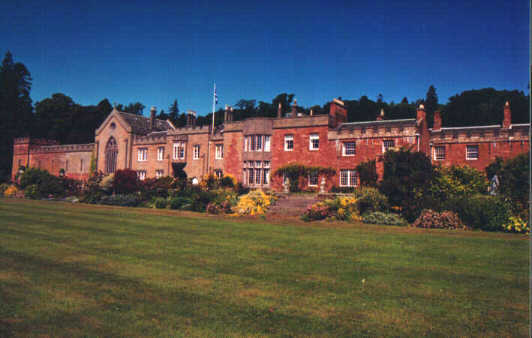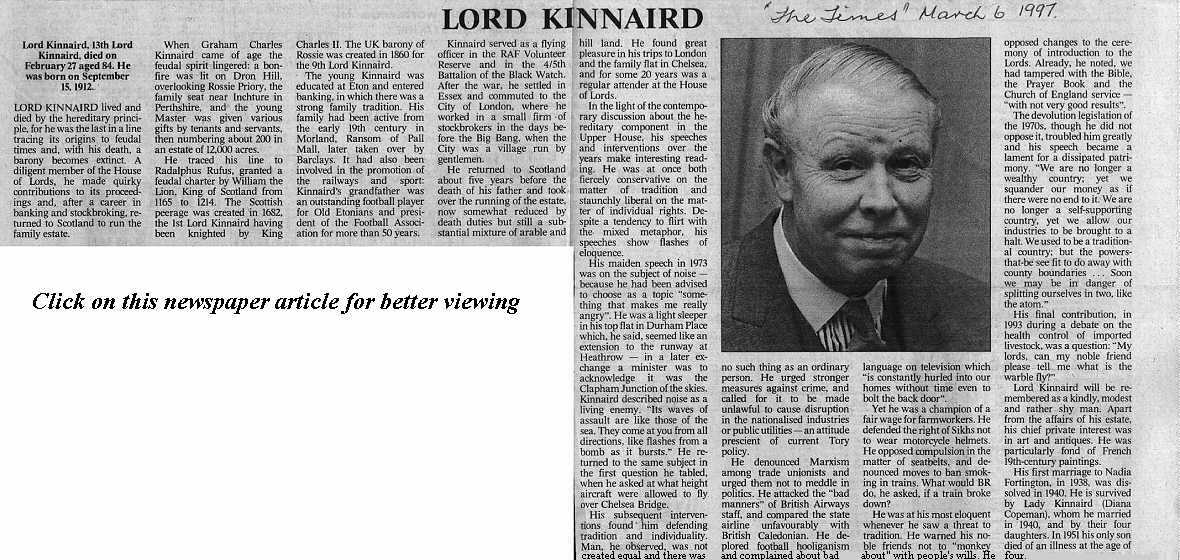Lord KINNAIRD Family - Start to
Finish
KINNAIRD: a local surname, derived from the barony of
Kinnaird in Perthshire, and composed of two Celtic words, ' Ceann ' and ' aird
', signifying the high end or head.
KINNAIRD, baron, a title in the peerage of Scotland
conferred in 1682, on Sir George Kinnaird of Inchture, descended from Radulphus, called
Ruffus (also spelt Rufus). King William the Lion bestowed by charter in 1170, the barony
of Kinnaird in the district of Gowrie. This charter is undated, but is witnessed by
Andrew, Bishop of Caithness. In consequence to this charter, Kinnaird became the surname
of the descendants. Nothing further is known of Radulphus Ruffus, except that he died
prior to 1214. The barony continued in possession of the family till the reign of Charles
I.
Kinnaird castle, supposed to have been built in the 12th century,
was in ruins for a very long time and has recently been renovated.
Richard de Kinnaird, the great grandson of Radulphus, was one of the Scots barons who
swore fealty to Edward I., in 1296. He is mentioned in Rymer's Foedera, in 1304. His son,
Radulphus de Kinnaird, also swore fealty to the same monarch the same year as his father.
Reginald de Kinnaird, second son of the latter's grandson, Richard de Kinnaird of that
ilk, married Marjory, daughter and heiress of Sir John Kirkaldy of Inchture, in the same
county, and got with her these lands, in which he was confirmed by charter of Robert III.,
dated 28th January 1899.
The ninth in direct descent from this Reginald, Sir George
Kinnaird of Inchture, 1st Lord Kinnaird, a steady loyalist during the civil wars, was knighted by Charles
II., in 1661. He represented the county of Perth in the Scots parliament, and was sworn a
Privy Councillor. On 28th December 1682 he was raised to the peerage by the title of Lord
Kinnaird of Inchture, with limitation to the heirs male of his body. He died 29th
September 1689. He had six sons, and George, the youngest, carried on the line of the
family. Patrick, the eldest, 2nd Lord Kinnaird,
died 18th February, 1701. He had, with a daughter, three sons. George, the
eldest, master of Kinnaird, predeceased him, without issue, in 1698. Patrick,
the second son, became 3rd Lord Kinnaird, and Charles, the youngest,
5th Lord Kinnaird.
Patrick, 3rd Lord Kinnaird, opposed the Union, and died in March
1715. His only son, Charles, 4th Lord Kinnaird, died without issue in September 1728, when the
title devolved on his uncle Charles, 5th Lord Kinnaird. The latter married, about 1729.
Magdalene, daughter of William Brown, merchant in Edinburgh and for eighteen years had no
issue. On 21st September, 1747, she left Drimmie House, the usual family residence, and
two days afterwards her husband intimated to his friends that she bad been delivered of
twins, named Patrick and Charles. The next heir, Mr. Charles Kinnaird, grandson of the
Hon. George Kinnaird, sixth and youngest son of the first lord, raised an action in the
commissary court, concluding that he ought to be allowed to prove that the pretended
delivery by Lady Kinnaird never took place and that the children were surreptitious. Lord
and Lady Kinnaird refused to answer to the interrogatories directed to be put to them by
the commissaries, who, on 1st January 1748, discerned his lordship to make payment to Mr.
Kinnaird of £600 sterling, for not appearing personally in court. This mysterious affair
terminated by Lord Kinnaird declaring that both the twins were dead.
Charles,
6th Lord Kinnaird, succeeded on the'
death of his predecessor, 16th July 1758, and died 2d August, 1767. He had several
children, but only two sons and three daughters survived. Patrick, the younger son, an
officer in the East India Company's service, was killed by a tiger on the coast of Coromandel in July 1771.
The elder son, George,
7th Lord
Kinnaird, and one of the sixteen Scots representative peers, died at Perth, 11th October
1805. He had married, 23d July, 1777, Elizabeth, daughter of Griffin Ransom of New Palace
Yard, Westminster, banker in London, and her grief for her husband's loss was so great
that she only survived him ten days. They had issue six sons and four daughters.
The fifth son, the Hon. Douglas James
William Kinnaird, an eminent banker, the friend both of Sheridan and Byron, was born
February 26, 1788. He received the early part of his education at Eton. He afterwards
passed some time at Gottingen, after which he went to Trinity college, Cambridge.
In
1811, he took his degree of Master of Arts. In 1813 he accompanied Mr.(afterwards Sir)
John Cam Hobhouse, baronet, (created in 1851 Lord Broughton,) through Sweden,
and across the north of Germany to Vienna. He was present at the decisive battle of Culin, in
Bohemia, in which the French, under General Vandamme, were beaten by the Prussians and
Russians. Subsequently he became an active partner in the banking-house of Ransom and
Morland, London, and, after the old partnership was dissolved, he took the principal
management of the business. In 1815, Mr. Kinnaird, Lord Byron, the Hon George Lamb, and
Mr. Peter Moore, formed the committee for directing the affairs of Drury-Lane theatre. He
was afterwards, for a short time, M.P. for Bishop's Castle. His name often occurs in the
Memoirs of Byron, and was one of the last which the noble poet was heard to pronounce.
The master of Kinnaird having died in his
infancy, Charles, 2nd son, became 8th Lord Kinnaird. He was born April 1780, and educated
at the Universities of  Edinburgh, Cambridge, and Glasgow. At the general election in 1802
he was chosen M.P. for Leominster, and distinguished himself in the house of commons by
his opposition to the then administration. He was at Venice when he succeeded to the title
in 1805. At the general election in the following year he was chosen one of the sixteen
Scots representative peers.
Edinburgh, Cambridge, and Glasgow. At the general election in 1802
he was chosen M.P. for Leominster, and distinguished himself in the house of commons by
his opposition to the then administration. He was at Venice when he succeeded to the title
in 1805. At the general election in the following year he was chosen one of the sixteen
Scots representative peers.
In 1817 he built the imposing pile of Rossie priory in the
parish of Inchture (properly Inchtower). in the Carse of Gowrie, for the
family mansion.
He married Lady Olivia Letitia Catherine Fitzgerald, youngest daughter of 2nd Duke of
Leinster.
George William Fox Kinnaird,
9th Lord Kinnaird, was born in
April 1807 and succeeded to the title when he was nineteen. He devoted much attention to
the management of his estates and was skilled in agriculture. He was a Freemason, and was
Grand-Master of Scotland 1830-31. He was Master of the Buckhounds 1839-41; a Privy
Councillor 1840; a Knight of the Order of the Thistle 1857; and Lord-Lieutenant of
Perthshire 1866-78. On 20 June 1831 he was created Baron Rossie of Rossie (Perth). He
married Frances Anna Georiana Ponsonby (daughter of William Francis Spencer Ponsonby,
first Baron de Mauley) in Canford. On 1 September 1860, his own male issue having failed, he
was created Baron Kinnaird of Rossie, with a specific remainder, failing heirs-male of his
own body, to his brother Arthur and the heirs-male of his body. He died at Rossie in 1878,
when the Barony of Rossie of 1831 became extinct.
Arthur FitzGerald,
10th Lord Kinnaird was
born 1814 and was originally christened Arthur Wellesley, after the great Duke. The
political views of the latter, however, not being to the mind of Lord Kinnaird's father,
he caused his son to alter his second name to Fitzgerald. But the Duke had a great
friendship with and a high esteem for his godson. As a young man, Lord Kinnaird was an
attaché to the Embassy at St. Petersburg 1835-37, but thereafter he left the diplomatic
service and entered his great-grandfather's bank, Ransom and Co., of which he succeeded to
the Peerage. He married Mary Jane Hoare and died in 1887.
Arthur FitzGerald,
10th Lord Kinnaird,
born 1847, was educated at Eton and Trinity College, Cambridge. He was a partner in
Barclay, Ransom and Co., Bankers; & Hon.Colonel Tay Division Submarine Miners. He
married Mary Alma Victoria Agnew, fifth daughter of Sir Andrew Agnew, eighth Baronet of
Lochnaw. In 1907 he was Lord High Commissioner to the Church of Scotland. He died
in 1923.
Douglas Arthur,
11th Lord Kinnaird, eldest son of Arthur Fitzgerald
inherited the title. He was killed in action in
1914. The title passed to his brother Kenneth FitzGerald
12th Lord Kinnaird. Kenneth was educated at Eton and
Trinity College, Cambridge. Kenneth served in the Great war 1914-18. He married Frances
Victoria Clifton. He died in 1972.
The 13th Lord Kinnaird was Graham
Charles Kinnaird. He was educated at Eton College and was lieutenant in 4/5th Battalion
Black Watch. He was married twice - Nadia Fortington (marriage dissolved) and Diana
Margaret Elizabeth Copeman. The only son and heir, Nicholas, was
killed in 1951. The Lord Kinnaird title died with the passing of Graham Charles Kinnaird
(13th Lord Kinnaird) in 1997.
Reference material: The Scottish
Nation by William Anderson and Scots Peerage, Vol.5

 Edinburgh, Cambridge, and Glasgow. At the general election in 1802
he was chosen M.P. for Leominster, and distinguished himself in the house of commons by
his opposition to the then administration. He was at Venice when he succeeded to the title
in 1805. At the general election in the following year he was chosen one of the sixteen
Scots representative peers.
Edinburgh, Cambridge, and Glasgow. At the general election in 1802
he was chosen M.P. for Leominster, and distinguished himself in the house of commons by
his opposition to the then administration. He was at Venice when he succeeded to the title
in 1805. At the general election in the following year he was chosen one of the sixteen
Scots representative peers. 